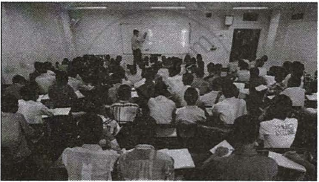Advertisements
Advertisements
प्रश्न
Find the value of k for which the system of linear equations has an infinite number of solutions:
(k – 1)x – y = 5,
(k + 1)x + (1 – k)y = (3k + 1).
उत्तर
The given system of equations:
(k – 1)x – y = 5
⇒ (k – 1)x – y – 5 = 0 ….(i)
And, (k + 1)x + (1 – k)y = (3k + 1)
⇒ (k + 1)x + (1 – k)y – (3k + 1) = 0 …(ii)
These equations are of the following form:
`a_1x+b_1y+c_1 = 0, a_2x+b_2y+c_2 = 0`
where, `a_1 = (k – 1), b_1= -1, c_1= -5 and a_2 = (k + 1), b_2 = (1 – k), c_2= -(3k + 1)`
For an infinite number of solutions, we must have:
`(a_1)/(a_2) = (b_1)/(b_2) = (c_1)/(c_2)`
i.e., `((k −1))/((k+1)) = (−1)/(−(k−1)) = (−5)/(−(3k+1))`
`⇒((k −1))/((k+1)) = 1/((k−1)) = 5/((3k+1))`
Now, we have the following three cases:
Case I:
`((k −1))/((k+1)) = 1/((k−1))`
`⇒ (k - 1)^2 = (k + 1)`
`⇒ k^2 + 1 – 2k = k + 1`
`⇒ k^2 – 3k = 0 ⇒ k(k – 3) = 0`
⇒ k = 0 or k = 3
Case II:
`1/((k−1)) = 5/((3k+1))`
⇒ 3k + 1 = 5k − 5
⇒ 2k = 6 ⇒ k = 3
Case III:
`((k −1))/((k+1)) = 5/((3k+1))`
⇒ (3k + 1) (k – 1) = 5(k + 1)
`⇒ 3k^2 + k – 3k – 1 = 5k + 5`
`⇒ 3k^2 – 2k – 5k – 1 – 5 = 0`
`⇒ 3k^2 – 7k – 6 = 0`
`⇒ 3k^2 – 9k + 2k – 6 = 0`
⇒ 3k(k – 3) + 2(k – 3) = 0
⇒ (k – 3) (3k + 2) = 0
⇒ (k – 3) = 0 or (3k + 2) = 0
`⇒ k = 3 or k = (−2)/3`
Hence, the given system of equations has an infinite number of solutions when k is equal to 3.
APPEARS IN
संबंधित प्रश्न
Draw a graph of the line x – 2y = 3. From the graph, find the coordinates of the point when (i) x = – 5 (ii) y = 0.
Obtain the condition for the following system of linear equations to have a unique solution
ax + by = c
lx + my = n
Find the values of a and b for which the following system of linear equations has infinite the number of solutions:
2x - 3y = 7
(a + b)x - (a + b - 3)y = 4a + b
Find the values of a and b for which the following system of equations has infinitely many solutions:
2x + 3y = 7
(a - 1)x + (a + 2)y = 3a
Solve for x and y:
`5/(x+y) - 2/(x−y) = -1, 15/(x+y) - 7/(x−y) = 10`
Solve for x and y:
`3/(x+y) + 2/(x−y)= 2, 3/(x+y) + 2/(x−y) = 2`
Find the values of a and b for which the system of linear equations has an infinite number of solutions:
(a – 1) x + 3y = 2, 6x + (1 – 2b)y = 6
Solve for x and y: `3/(x+y) + 2/(x−y) = 2, 9/(x+y) – 4/(x−y) = 1`
Find the value of k, if the point P (2, 4) is equidistant from the points A(5, k) and B (k, 7).
Read the following passage:
|
A coaching institute of Mathematics conducts classes in two batches I and II and fees for rich and poor children are different. In batch I, there are 20 poor and 5 rich children, whereas in batch II, there are 5 poor and 25 rich children. The total monthly collection of fees from batch I is ₹9,000 and from batch II is ₹26,000. Assume that each poor child pays ₹x per month and each rich child pays ₹y per month.
|
Based on the above information, answer the following questions:
- Represent the information given above in terms of x and y.
- Find the monthly fee paid by a poor child.
OR
Find the difference in the monthly fee paid by a poor child and a rich child. - If there are 10 poor and 20 rich children in batch II, what is the total monthly collection of fees from batch II?

